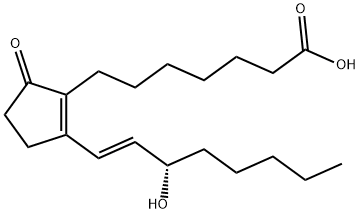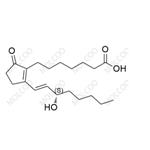Prostaglandin B1 is a novel microbial biopolymer which has been shown to improve the longevity of type 2 diabetic rodents. Oligomers of prostaglandin B1 inhibit arachidonic acid mobilization in human neutrophils and endothelial cells.
ChEBI: Prostaglandin B1 is a member of the class of prostaglandins B that is prosta-8(12),13-dien-1-oic acid carrying oxo and hydroxy substituents at positions 9 and 15 respectively (the 13E,15S-stereoisomer). It has a role as a human metabolite. It is a conjugate acid of a prostaglandin B1(1-).
Prostaglandin B1 (PGB1) is a metabolic product of PGE1 dehydration. It is known to specifically bind to peroxisome proliferator-activated receptor-γ. By this, PGB1 mediates f at accumulation and metabolism. Oligomerization of PGB1 potentiates its anti-oxidative property.
This eicosanoid (FWB1 (free-acid) = 336.47 g/mol; CAS 13345-51-2, for PGB1,
and 39306-29-1, for Bx) is a metabolite of prostaglandin E1: prostaglandin
Bx is an oligomer of prostaglandin B1. The X-ray crystal structure of
prostaglandin B1 suggests this prostaglandin has an unusual L-shaped
configuration, with the a and w side chains roughly perpendicular to one
another. The 15-hydroxyl group, which is normally directed away from
the centroid of the prostaglandin in the standard hairpin mod+el, is turned
inward in prostaglandin B1. Target (s) : FoF1 ATPase, or H-transporting
two-sector ATPase, inhibited by prostaglandin Bx; 15-
hydroxyprostaglandin dehydrogenase; phospholipase A2, inhibited by
prostaglandin Bx.

